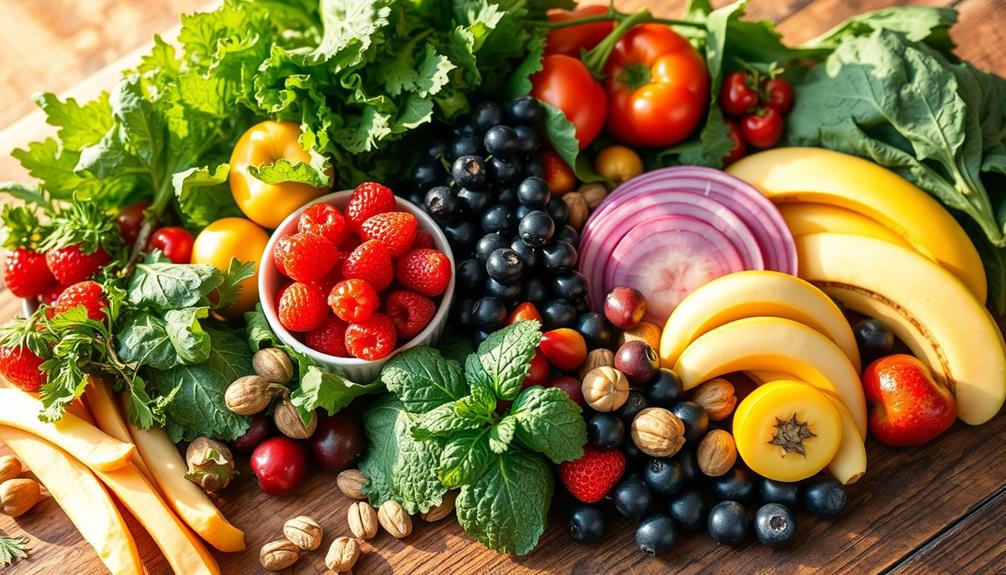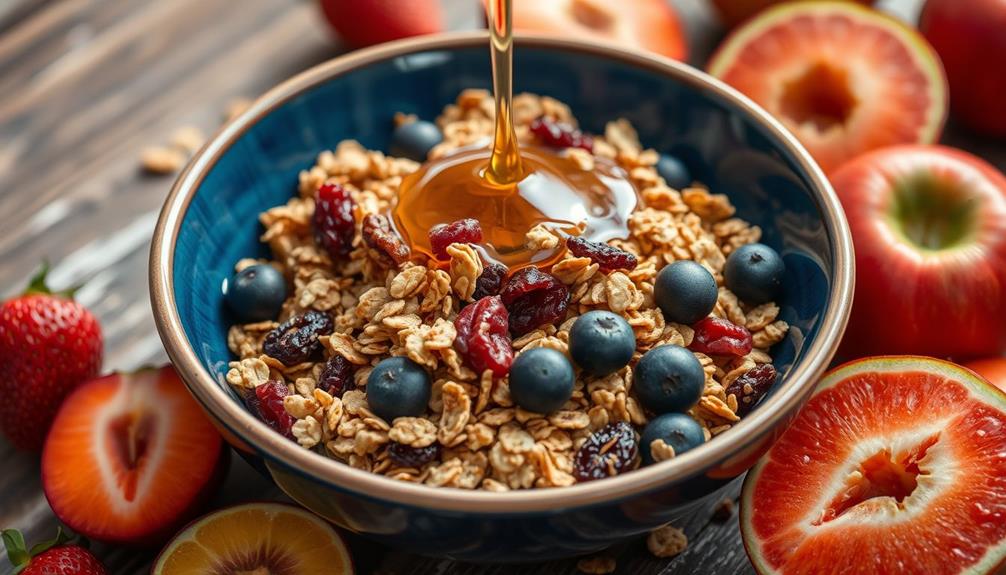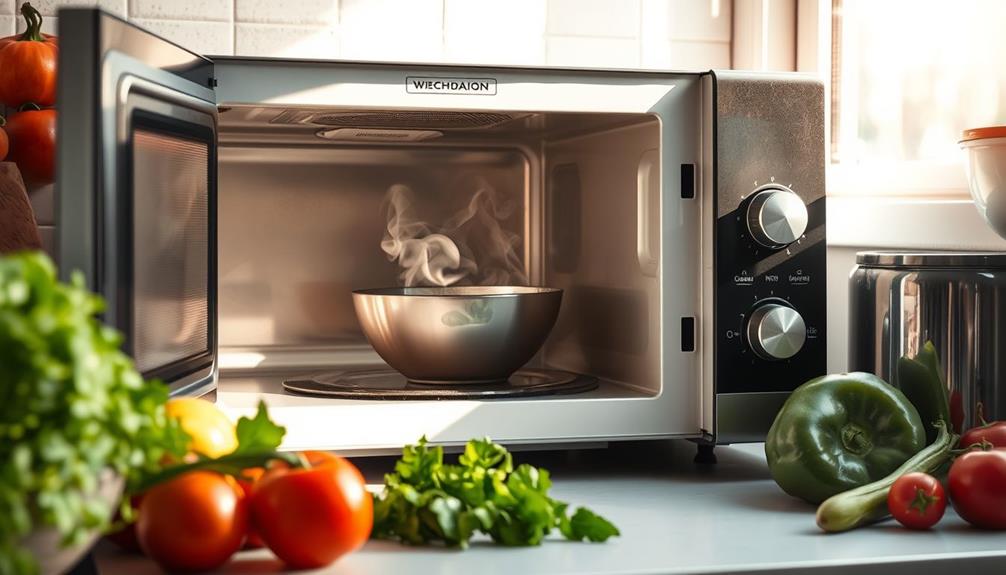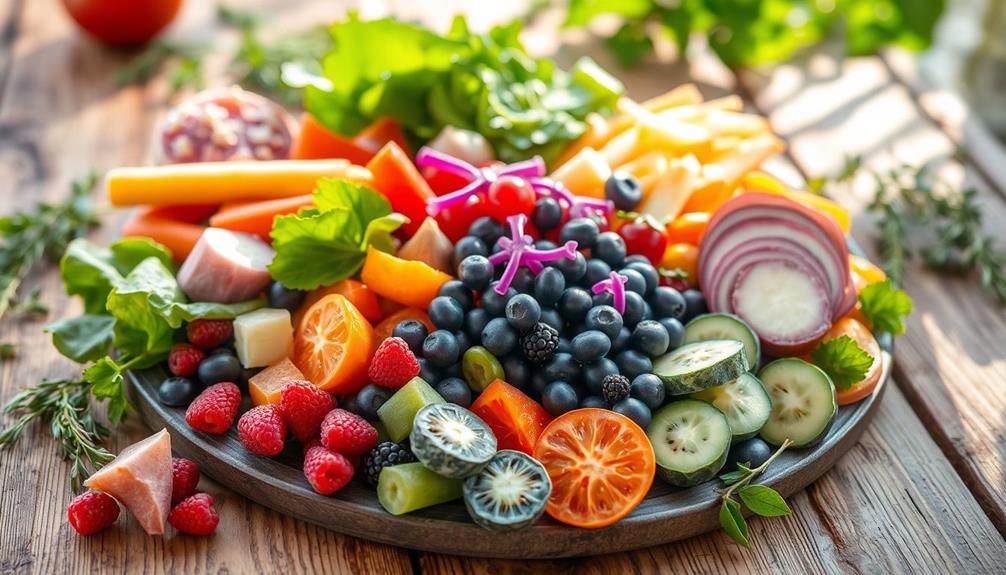Raw food refers to ingredients that aren't heated above 42°C (118°F). This low-temperature cooking preserves their natural enzymes and nutrients, making them more nutritious. Typically, you'll focus on fresh fruits, vegetables, nuts, seeds, herbs, and spices. Some people follow strict raw diets, like raw veganism, which excludes all animal products. Others might include raw dairy or even raw meats. The flexibility of raw diets allows you to adjust them to your preferences. If you're curious about preparation techniques or popular recipes, there's a lot more to explore!
Key Takeaways
- Raw food refers to ingredients not heated above 42°C (118°F), preserving their natural enzymes and nutritional value.
- The diet consists mainly of fresh fruits, vegetables, nuts, seeds, herbs, and spices, focusing on plant-based foods.
- Raw vegan diets eliminate all animal products, while raw vegetarian and omnivorous diets include dairy or raw animal products, respectively.
- Raw foods offer high nutrient density, enhancing digestion, supporting weight management, and providing antioxidants that reduce chronic disease risk.
- Proper preparation techniques like soaking, sprouting, and fermenting enhance digestibility and nutrient availability in raw foods.
Definition of Raw Food
When it comes to understanding raw food, it's essential to recognize that it refers to ingredients not heated above 42°C (118°F). This low-temperature approach aims to preserve the natural enzymes and nutritional value of the foods you consume.
A raw food diet can enhance nutrient absorption and promote weight loss through the consumption of low-calorie, high-fiber foods, which not only contribute to overall health but also increase energy levels. In a raw food diet, you'll mainly find fresh fruits, vegetables, nuts, seeds, herbs, and spices, with an emphasis on organic and locally sourced options.
Benefits of raw food include improved immune function due to high vitamin and antioxidant levels.
Cooking processes that exceed 42°C can destroy crucial nutrients, including essential vitamins and minerals, which are important for your overall health. While many raw food diets exclude animal products, some may include uncooked animal products like raw eggs, fish, and unpasteurized dairy.
If you choose to follow a strictly raw vegan diet, you'll eliminate all animal products, focusing solely on plant-based foods.
The core principle of a raw food diet is consuming unprocessed, whole foods in their natural state without employing high-temperature cooking methods. This approach not only promotes a healthier lifestyle but also encourages a deeper connection with the ingredients you eat.
Nutritional Benefits
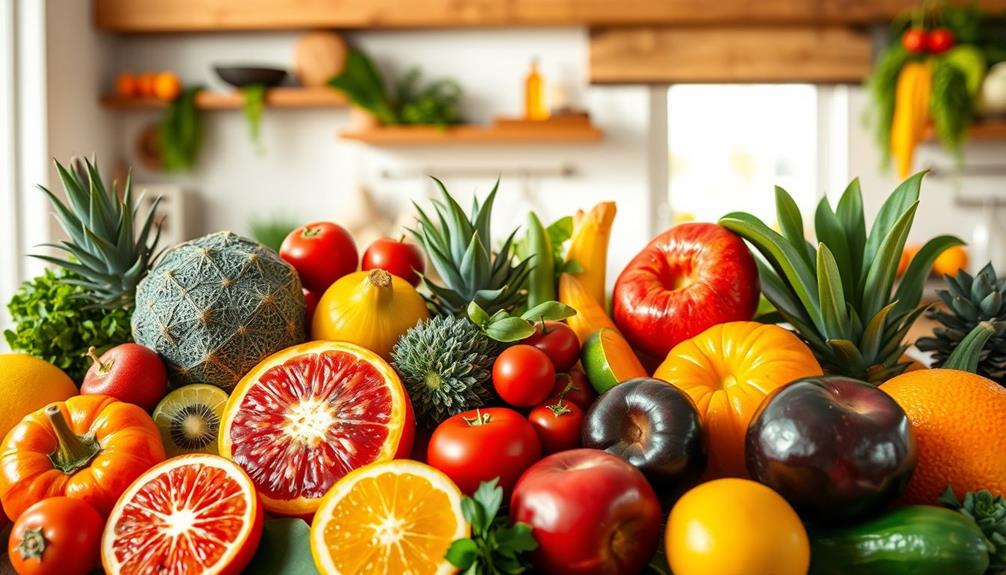
When you choose raw foods, you're packing your diet with high nutrient density that's often lost in cooking.
These foods not only enhance digestion but also support weight management thanks to their fiber content.
For instance, the high fiber in raw fruits and vegetables can help maintain healthy digestion and prevent gastrointestinal discomfort.
High Nutrient Density
Raw food diets are celebrated for their high nutrient density, offering an array of essential vitamins and minerals that often surpass those found in cooked foods. When you choose raw foods, you're consuming fruits and vegetables that retain their natural enzymes and nutrients, which can be greatly diminished through cooking methods like boiling.
For instance, boiling can cut vitamin C content in vegetables by up to 50%, making raw options a more vibrant choice for your health. Furthermore, embracing a raw food approach can align with the growing interest in natural remedies alongside conventional medications, further enhancing your overall wellness.
Incorporating raw foods into your diet means you also boost your intake of antioxidants, which help combat oxidative stress and may reduce the risk of chronic diseases. Additionally, the high nutrient density of raw fruits and vegetables can lead to increased fiber intake, promoting satiety and supporting digestive health.
Enhanced Digestion Benefits
Eating raw foods not only boosts nutrient intake but also greatly enhances digestion. These foods retain natural enzymes that aid in breaking down nutrients, making it easier for your body to absorb them. The high fiber content in raw fruits and vegetables promotes regular bowel movements, ensuring your digestive tract stays healthy.
Additionally, incorporating certain essential oils like peppermint oil can provide invigorating digestive support and alleviate nausea associated with heavy meals.
When you consume raw foods, you're also increasing your intake of prebiotics, which feed beneficial gut bacteria. This helps create a balanced microbiome, essential for optimal digestive health.
Additionally, fermented raw foods like sauerkraut and kimchi introduce probiotics into your diet, further supporting your gut flora and enhancing digestion.
The minimal processing of raw foods preserves their necessary vitamins and minerals, which are critical for various digestive processes in your body. Keeping these nutrients intact means your digestive system can function more efficiently, reducing discomfort and promoting overall gut health.
Weight Management Support
Incorporating raw foods into your diet can greatly support weight management efforts. A raw food diet is generally low in calorie density, allowing you to enjoy larger portions while keeping your caloric intake in check. This can be especially beneficial for weight loss, as it helps you feel satisfied without overeating.
Additionally, the high antioxidant content in many raw fruits and vegetables can provide numerous health benefits, including rich in antioxidants, which may contribute to overall wellness.
The high fiber content found in raw fruits, vegetables, nuts, and seeds plays an essential role in this process. Fiber aids digestion and enhances feelings of fullness, which can lead to reduced overall food consumption.
Studies show that individuals following a raw food diet often experience reductions in body weight, BMI, and waist circumference compared to those who consume cooked foods.
Additionally, raw foods contain natural enzymes that facilitate better digestion and nutrient absorption. This can support your metabolism, making it easier to maintain a healthy weight.
By incorporating more raw foods into your meals, you can also displace higher-calorie processed options, promoting healthier eating patterns that contribute to long-term weight control.
Embracing raw foods doesn't just enhance your diet; it can be a powerful ally in your weight management journey.
Types of Raw Food Diets

When exploring types of raw food diets, you'll find options that range from strict raw vegan to more flexible vegetarian and omnivorous choices.
Each of these diets offers unique benefits and allows for varying degrees of dietary flexibility.
Additionally, integrating technology into your meal planning can enhance your experience and creativity in preparing raw foods, much like fostering a digital-friendly environment at home.
Understanding these options can help you choose a raw food approach that best fits your lifestyle and preferences.
Raw Vegan Options
Many people exploring raw food diets find themselves drawn to the raw vegan option, which focuses solely on plant-based foods. This raw vegan diet excludes all animal products, allowing you to enjoy a variety of raw fruits, vegetables, nuts, seeds, and sprouted grains. By committing to this lifestyle, you embrace a wholesome and nutrient-rich way of eating that emphasizes the benefits of fresh, unprocessed ingredients.
Curiously, the principles of this diet can be seen as a parallel to the ethos of ethical sourcing and community support found in sustainable coffee practices.
In a raw vegan diet, you'll discover creative ways to prepare meals that maintain the integrity of the ingredients. Think smoothies packed with raw fruits, salads bursting with vibrant veggies, and snacks made from dehydrated nuts or seeds. These options allow you to enjoy diverse flavors while fueling your body with essential nutrients.
While some raw food enthusiasts may occasionally include minimal cooked foods, the raw vegan diet strictly adheres to all-raw principles. This adherence guarantees that you're maximizing the health benefits and enzymes found in uncooked plant-based foods.
Dietary Flexibility Explained
Dietary flexibility is a key aspect of raw food diets, allowing individuals to tailor their eating habits to suit personal preferences and nutritional needs. You have several options when it comes to raw food diets, each catering to different lifestyles.
The Raw Vegan Diet excludes all animal products, focusing solely on plant-based foods like fruits, vegetables, nuts, and seeds. If you want to include some animal products, the Raw Vegetarian Diet allows for unprocessed dairy and raw eggs alongside raw plant-based foods.
Incorporating a variety of raw foods can enhance nutritional diversity, which is essential for overall health and well-being. Understanding common dietary strategies, like creating a personal budget, can also help in planning meals that align with financial goals.
For those who prefer a broader range, the Raw Omnivorous Diet combines raw plant foods with raw animal products, including meat and fish. This variety can enhance your diet while still adhering to raw principles.
Many people embrace dietary flexibility by incorporating minimal cooked foods into their raw food regimen, enriching their meals without strict limitations.
Ultimately, personal choice plays a significant role in how you approach raw food diets. Whether you see it as a lifestyle commitment or a dietary choice, you can adjust your eating habits to fit your unique needs and preferences.
Essential Preparation Techniques
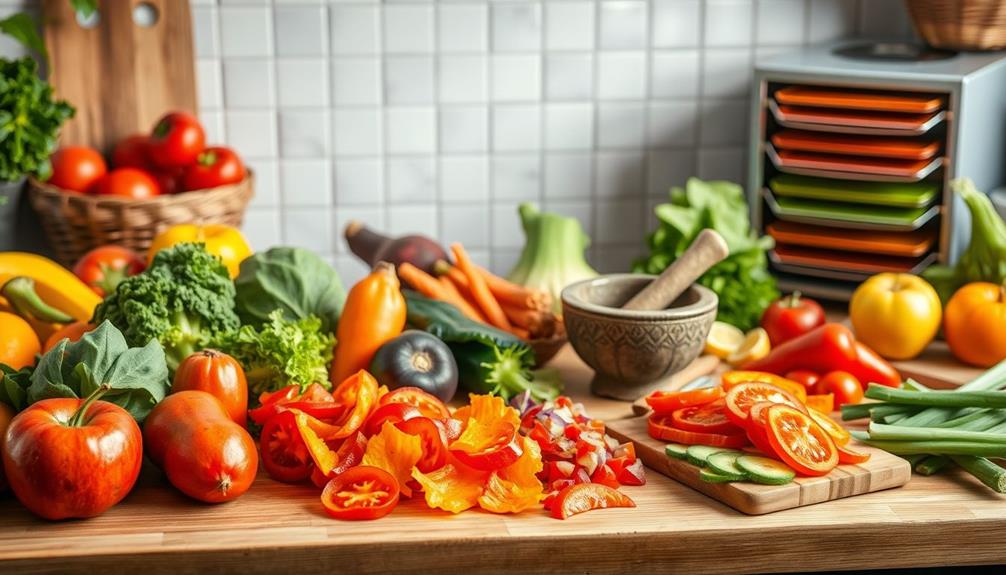
To fully embrace the raw food lifestyle, you'll want to master essential preparation techniques that enhance flavor and nutritional value. One vital method is soaking, which involves immersing beans and grains in water. This process not only enhances digestibility but also reduces anti-nutrients, making these ingredients easier to incorporate into your raw meals.
In addition, experimenting with different water temperatures during soaking can yield varying flavors, similar to how coffee enthusiasts explore their favorite brews.
Next, consider sprouting. Germinating seeds and grains increases their nutrient availability and enhances flavor, giving your dishes a delightful crunchy texture. It's a simple way to boost the health benefits of your meals.
Fermenting is another valuable technique. By allowing raw vegetables to undergo controlled bacterial growth, you can promote gut health while enhancing flavors, as seen in delicious dishes like raw sauerkraut.
Moreover, incorporating fermented foods into your diet can provide beneficial probiotics, akin to how coffee can improve focus during workouts, coffee and exercise performance.
Also, blending and juicing are great for creating smoothies and juices that preserve the nutrients of raw ingredients, providing a quick and easy way to enjoy a variety of fruits and vegetables.
Finally, dehydrating fruits and veggies allows you to create snacks like raw crackers and fruit leathers without cooking.
Mastering these preparation techniques will elevate your raw food experience and keep your meals both nutritious and flavorful.
Flexibility in Raw Diets

Flexibility is key when it comes to raw diets, allowing you to tailor your meals to fit your personal preferences and health needs.
Incorporating a variety of foods can guarantee you receive essential nutrients, which is critical for overall well-being, especially in the context of key domains of development.
You might choose to include some cooked foods for better digestion or simply for enjoyment, making the diet more sustainable.
Embracing this variability can help you create a balanced approach that works best for you.
Diet Variability Options
Many people find that the raw food diet offers a range of options tailored to individual tastes and health objectives. You can choose from various interpretations, such as raw vegan, raw vegetarian, or raw omnivorous diets. This flexibility allows you to create raw food recipes that resonate with your preferences and nutritional needs.
Incorporating elements of mindfulness practices to reduce emotional eating can also enhance your raw food experience, making it more enjoyable and fulfilling effective strategies for weight loss.
You're not limited to a strict 100% raw eating regimen; many individuals incorporate minimal cooked foods to maintain balance. For example, you might enjoy sun-cured olives while avoiding processed canned varieties, highlighting how you can adapt the diet to suit your lifestyle.
Embracing a sustainable raw food approach means you can include raw meals without entirely eliminating cooked foods, promoting long-term dietary flexibility. This adaptability makes the raw diet more approachable and enjoyable.
Ultimately, it's all about personal choice. Whether you dive fully into the raw food lifestyle or simply integrate raw meals into your existing eating habits, you have the power to shape your raw diet according to what works best for you.
This versatility can make your journey both satisfying and sustainable.
Personal Choice Importance
Embracing personal choice is essential when maneuvering the raw food diet, as it allows you to tailor your eating habits to fit your unique lifestyle and health goals. The raw food diet isn't an all-or-nothing approach; you can incorporate varying amounts of raw foods alongside cooked options. This flexibility helps you maintain a sustainable lifestyle while meeting your nutritional requirements.
Many raw foodists identify with different dietary labels, such as raw vegan or raw omnivorous, reflecting their personal preferences and health needs. Starting with small changes, like including one raw meal a day or week, can make the conversion more manageable and enjoyable.
Here's a simple table that highlights the importance of personal choice in your raw food journey:
| Flexibility Options | Personal Impact | Nutritional Balance |
|---|---|---|
| Raw vegan | Aligns with ethical values | High in fruits and veggies |
| Raw omnivorous | Incorporates proteins | Balanced diet with nutrients |
| Mix of raw and cooked | Customizes taste | Addresses unique needs |
Ultimately, your personal experiences and health goals are what guide the right balance of raw and cooked foods, emphasizing the importance of customization in your dietary choices.
Cooking Inclusion Considerations
Incorporating cooked foods into your raw diet can enhance both enjoyment and nutrition. Many people find that allowing some flexibility with cooked food helps them maintain a sustainable raw food diet. You don't have to be all-or-nothing; instead, focus on a high raw food intake while including small amounts of unprocessed cooked foods based on your preferences and health needs.
Cooking methods that keep temperatures below 118°F (49°C) are ideal, as they minimally alter the nutritional profile of the ingredients. Lightly steaming vegetables or using sprouted grains can boost nutrient absorption and digestibility without straying from the raw food philosophy.
This balance not only makes the shift to a raw food diet easier but also encourages a more enjoyable eating experience.
Potential Risks and Challenges
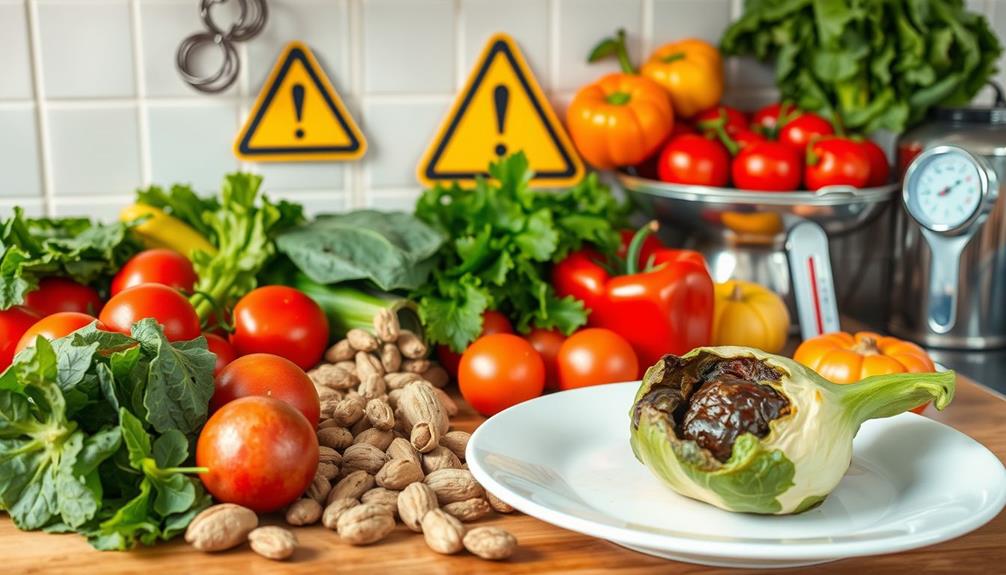
Often, people overlook the potential risks and challenges of a strictly raw food diet. While incorporating more raw foods can be beneficial, it's essential to recognize that this approach can lead to nutrient deficiencies. Essential nutrients like vitamin B12, iron, calcium, and omega-3 fatty acids may become lacking, often requiring you to take into account supplementation.
Additionally, some raw foods, such as kidney beans and cassava, contain toxic compounds that cooking can neutralize. Consuming these foods raw can pose serious health risks. The dangers extend to raw animal products too; eggs and fish might carry pathogens like Salmonella and E. coli, heightening the risk of food poisoning if not sourced and handled carefully.
Moreover, preparing raw meals is time-intensive, involving processes like soaking, sprouting, and dehydrating, which can be overwhelming for those with busy lifestyles.
Popular Raw Food Recipes
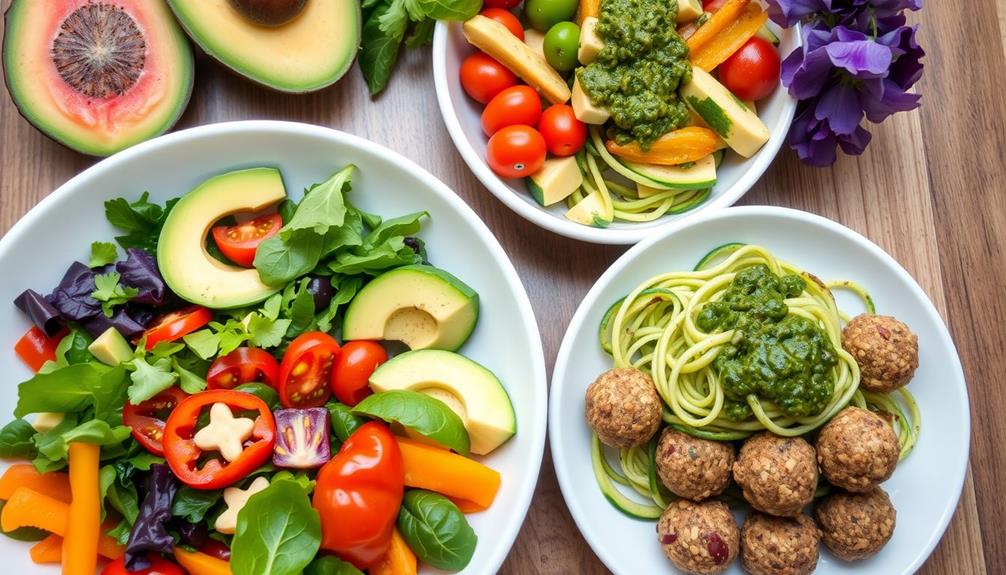
When considering a raw food diet, you'll find an array of delicious and nutritious recipes that can make the journey enjoyable. For a savory option, try Raw Lasagne, which layers fresh zucchini with creamy cashew cheese, or whip up a revitalizing Raw Pad Thai made from spiralized vegetables and a rich almond sauce. These dishes showcase how raw foods can be both satisfying and flavorful.
If you have a sweet tooth, there are plenty of tempting raw desserts. Indulge in a raw chocolate cake or energy balls made from nuts, seeds, and natural sweeteners. These treats offer a delightful way to enjoy dessert without any cooking involved.
For snacks, consider dehydrated options like raw crackers or fruit leather. They retain their nutritional value while providing a satisfying crunch.
Smoothies and raw soups are also quick and easy to prepare; just blend fresh fruits and vegetables for a nutritious meal on the go.
Don't forget about fermented dishes like raw sauerkraut and kimchi, which not only enhance flavor but also promote gut health with beneficial probiotics.
These popular recipes make embracing a raw food lifestyle both enjoyable and rewarding.
Impact on Weight Management
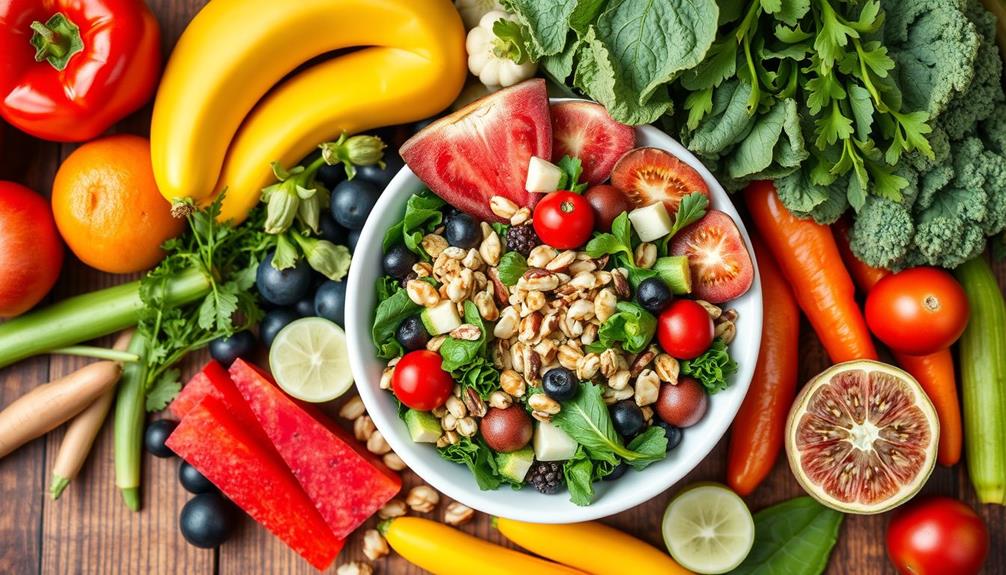
Adopting a raw food diet can greatly impact your weight management efforts. Raw foods are typically lower in calorie density, which means you can enjoy larger portions without consuming excessive calories. This can make it easier for you to lose weight while still feeling full and satisfied.
The high fiber content in raw fruits and vegetables plays an essential role in this process, supporting your digestive health and helping to regulate your appetite.
By focusing on raw foods, you're likely to reduce your intake of processed foods high in added sugars and unhealthy fats. This shift can lead to improved weight management outcomes, as many individuals on a raw food diet report significant weight loss—some even shedding up to 20 pounds in just a few weeks.
Moreover, the natural enzymes found in raw foods may enhance your digestion, potentially boosting your metabolism and further supporting your weight maintenance efforts.
Dietary Considerations and Restrictions
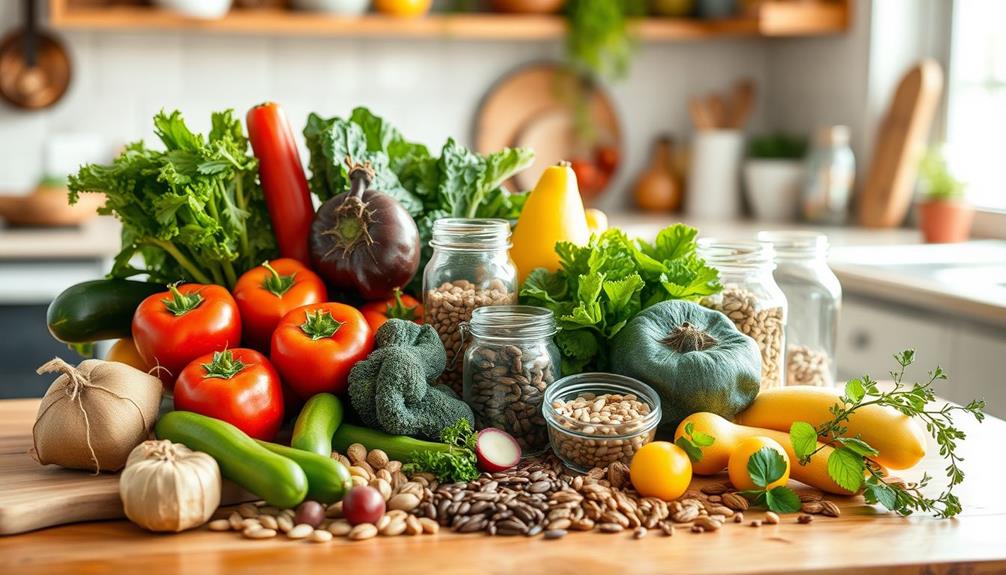
Guiding a raw food diet requires careful consideration of what you eat to guarantee you're meeting your nutritional needs. A raw food diet primarily consists of unprocessed, uncooked plant-based ingredients like fruits, vegetables, nuts, seeds, and sprouted grains.
If you're following a raw vegan diet, you'll exclude all animal products, while a raw omnivorous approach may allow for some raw animal products and unprocessed cooked foods.
It's essential to be aware of certain dietary considerations. For instance, some raw foods, such as kidney beans and cassava, can be toxic if not prepared properly. Consequently, careful selection and preparation are fundamental for food safety.
Additionally, nutritional planning is critical to prevent deficiencies in key nutrients, particularly vitamin B12, iron, and omega-3 fatty acids, especially if you're strictly plant-based.
To ease into this lifestyle, consider gradually introducing raw foods into your diet. This approach not only promotes sustainability but also accommodates your personal preferences, since a fully raw diet may not be suitable for everyone.
Make sure you're informed and prepared to make the best choices for your health.
Resources for Raw Food Enthusiasts
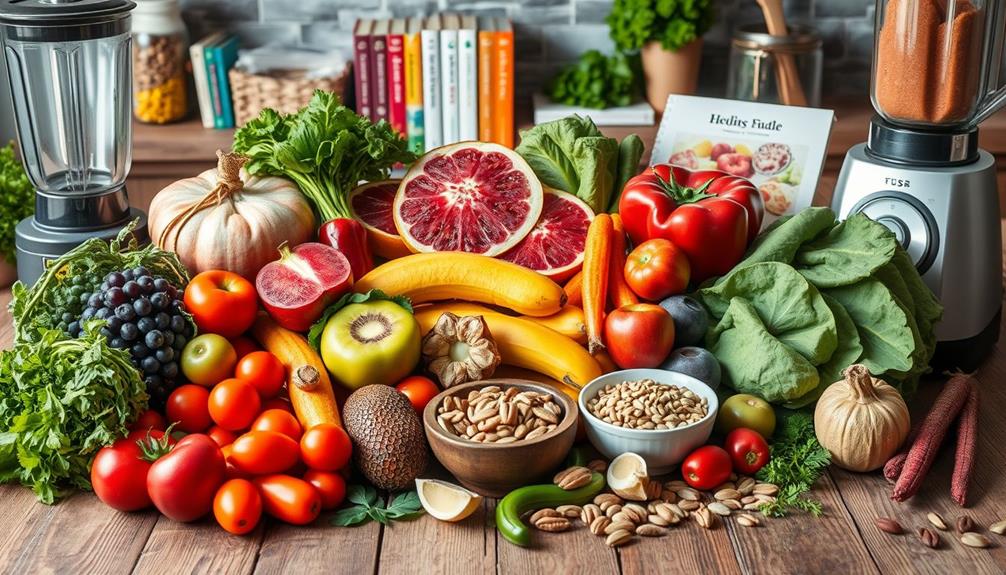
For those passionate about the raw food lifestyle, a wealth of resources is available to enhance your journey. You can explore a variety of online platforms, including blogs and websites that focus on raw vegan recipes, offering countless meal and snack ideas.
Social media is another fantastic tool; by following hashtags like #rawfood and #rawvegan, you can connect with fellow raw food enthusiasts who share their experiences, tips, and creative recipes.
Consider subscribing to newsletters from raw food advocates, as they often provide exclusive recipes, meal plans, and insights into the latest trends in raw food preparation.
If you're looking to equip your kitchen, local and online stores offer specialty products like dehydrators and sprouting kits, making it easier to prepare delicious raw meals.
Joining forums and groups dedicated to raw foods can also be incredibly beneficial. These communities offer support, motivation, and a wealth of shared knowledge among like-minded individuals, helping you stay inspired and informed on your raw vegan journey.
With these resources at your fingertips, you'll find it easier to embrace and enjoy the raw food lifestyle.
Frequently Asked Questions
What Is the Meaning of Raw Food?
Raw food means you're consuming unprocessed, uncooked ingredients like fruits, vegetables, nuts, and seeds. It emphasizes preserving natural enzymes and nutrients, enhancing your energy and health by avoiding high-heat cooking methods.
What Is the Raw Food Diet Full Explanation?
You know the saying, "You are what you eat." The raw food diet emphasizes unprocessed, uncooked plant-based foods. It boosts energy and detoxification, but careful planning's essential to avoid nutrient deficiencies. Enjoy vibrant, wholesome meals!
What Is an Example of a Raw Food?
An example of a raw food is fresh spinach. You can enjoy it uncooked, preserving its nutrients and flavors. Other options include raw fruits, nuts, and vegetables, all offering health benefits in their natural state.
What Is Considered Eating Raw?
Eating raw is like releasing nature's purest energy. You're savoring fresh fruits, crunchy veggies, nuts, and seeds, all while skipping traditional cooking methods. It's all about preserving nutrients and feeling vibrant every single day.
Conclusion
Embracing a raw food diet is like tending to a vibrant garden, where every fresh ingredient thrives and nourishes your body. By choosing this path, you're not just feeding yourself; you're cultivating health and vigor. Remember, flexibility allows you to adapt and grow, just as plants flourish in varying conditions. So, immerse yourself in the world of raw foods, experiment with flavors, and watch your well-being bloom. Your journey to wellness starts with the seeds of fresh choices!

